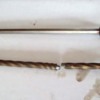(1) The OEM oil pump shaft does not shear. It doesn't break. I've never in my whole life known a single person to have their Ford vehicle strand them somewhere due to a failure related to the OEM oil pump drive shaft. Neither have any of you. I can recommend the OEM drive shaft with confidence, knowing my advice will not cause you problems down the road.
(2) On the other hand, I have known MANY people who have been stranded due to the distributor gear roll pin shearing
after installation of the heavy duty oil pump drive shaft. Therefore I cannot recommend that part to you, because I have no confidence it will not give you trouble.
(3) The heavy duty oil pump drive shaft WAS NOT designed to rectify problems with the OEM shaft failing, because it doesn't fail. It was originally advertised to prevent "spark scatter". So unless you are experiencing problems with spark scatter, you do not "NEED" the heavy duty shaft. I don't even know what the symptoms of spark scatter are to describe them to you.
(4) The heavy duty shaft is the solution to a problem you didn't know you had.
(5) On the other hand, if you like being stranded on the road, if you like paying tow bills, be my guest.

There's a saying "if it ain't broke, don't fix it". Besides, for the price of that shaft I can purchase a nice bottle of Scotch Whiskey.
Ever wondered how much it takes to snap the OEM shaft? Quite a bit.
See below.


